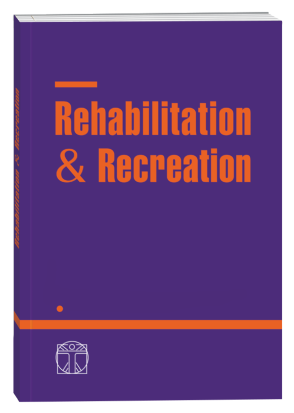RESPIRATORY GYMNASTICS IN REHABILITATION COMPLEXES AFTER MYOCARDIAL INFARCTION
DOI:
https://doi.org/10.32782/2522-1795.2022.10.4Keywords:
myocardial infarction, therapeutic exercises, respiratory rehabilitation.Abstract
Goal – to increase the effectiveness of therapeutic exercises by applying special breathing exercises inpatients with myocardial infarction.Methods. Hypoxic tests were performed in two versions: with a breath hold on an inhalation (Stange test)and a breath hold on an exhalation (Gencha test). The results were evaluated by the duration of the breath-holding time and by the rate of chronotropic response of the heart to breath-holding. Chronotropic responsewas determined by the ratio of heart rate after the end of the test to the original heart rate. The inspiratoryand expiratory hypoxic indices were also calculated as the quotient of dividing the duration of breathholding (sec) by the heart rate (beats/min).Results. Under the influence of the rehabilitation complex, an increase in the indices of hypoxic testsof Stange and Gencha was statistically significant in both the main and control groups. But when comparingthem with each other, the final indicators of these samples in the main group were statistically significantlybetter: t = 3.03 and 3.12, respectively, p < 0.01. Calculation of hypoxic indices during the final studyshowed a statistically significant predominance of positive dynamics in the main group by the inspiratoryindex (0.657 ± 0.013 conventional units) when compared with the control (0.552 ± 0.016 conventionalunits) and expiratory index: respectively 0.657 ± 0.013 conv.ed and 0.445 ± 0.011 conventional units(t = 5.09 and 5.94; p < 0.001).Conclusion. In patients after myocardial infarction at the stationary stage of rehabilitation, externalrespiration indexes according to the results of Stange and Gencha hypoxic tests with an assessmentof the chronotropic response of the heart to breath holding, as well as inspiratory and expiratory hypoxicindices obtained during the initial study, were reduced. In order to increase the effectiveness of medicalgymnastics, special breathing exercises were used for half-bed and free motor regimes using elementsof pranayama of the Indian health system of hatha yoga. After the rehabilitation course, the modifiedtherapeutic gymnastics technique that we modified turned out to be more effective than the generallyaccepted one, which has a statistically significant confirmation and therefore allows us to recommend it forimplementation.
References
Аронов Д. М., Лупанов В. П. Функцио-нальные пробы в кардиологии. Москва :МЕДпресс-информ, 2002. 296 с.
Белая Н. А. Руководство по лечебномумассажу, 2-е изд. Москва : «Медицина», 1983.288 с.
Бубнова М. Г., Аронов Д. М. Клиничес-кие эффекты годичной программы кардио-реабилитации с применением физическихтренировок после острого инфаркта мио-карда у больных трудоспособного возрастас разным реабилитационным потенциалом.Кардиоваскулярная терапия и профилак-тика. 2019. № 5. С. 27–34.
Будневский А. В. Легочная реабили-тация как эффективный метод оптимизациилечебно-профилактических мероприятийу больных хронической обструктивной болез-нью легких с метаболическим синдромом.Терапевтический архив, 2016. № 8. С. 25–29.
Ватутин Н. Т. Легочная реабилитацияв комплексном лечении больных с хроничес-кой обструктивной болезнью легких: местоглубокого йоговского дыхания. Вестниквосстановительной медицины, 2016. № 2.С. 62–68.
Велитченко В. К., Велитченко Н. В.,Велитченко Е. В. Значение дозированныхфизических тренировок в восстановлениибольных, перенесших инфаркт миокарда.Российский кардиологический журнал, 2006.№ 1(57). С. 34–37.
Кемалов Р. Ф. Эффективность физичес-кой реабилитации больных инфарктом мио-карда. Паллиативная медицина и реабилита-ция, 2006. № 1. С. 18–21.
Клапчук В. В., Курята А. В., Марги-тич С. В. Волевое управление дыханиемв медицинской и спортивной практике;изд. 2-е перераб. и дополн. Днепр : Изд.ФОП Половко, 2018. 120 с.
Медицинская реабилитация: Руковод-ство для врачей; под ред. В. А. Епифанова.Москва : МЕДпресс-информ, 2005. 328 с.
Миланов А., Борисова І. Вправи йогів;пер. с болг. Київ : Здоров’я, 1971. 144 с.
Некоркина О. А. Лечебная физкуль-тура в статико-динамическом режиме приостром инфаркте миокарда : автореф. дис. …канд. мед. наук. Москва, 2002. 18 с.
Оюнарова Т. Н., Марков В. А., Мар-ков В. А., Черногорюк Г. Э., Антипов С. И.,Антипов С. И., Катков В. А. Особенностиклинического течения острого инфаркта мио-карда у пациентов с хронической обструктив-ной болезнью легких. Современные проблемынауки и образования. 2013. № 1.
Поллок М. Л., Шмидт Д. Х. Заболева-ния сердца и реабилитация. Киев : Олимпий-ская литература, 2000. 408 с.
Стентон Гланц. Медико-биологичес-кая статистика; пер. с англ. Москва : Прак-тика, 1999. 459 с.
Ruff C. T., Braunwald E. The evolvingepidemiology of acute coronary syndromes. Nat.Rev. Cardiol. 2011; 8(3): 140–7.
Chan P. S., McNally B., Nallamothu B. K.,Tang F., Hammill B. G., Spertus J. A. et al. Long-term outcomes among elderly survivors of out-of-hospital cardiac arrest. J. Am. Heart Assoc.2016; 5(3): e002924.
Priori S. G., Blomström-Lundqvist C.,Mazzanti A., Blom N., Borggrefe M., Camm J.et al. 2015. ESC Guidelines for the managementof patients with ventricular arrhythmiasand the prevention of sudden cardiac death:The Task Force for the Management of Patientswith Ventricular Arrhythmias and the Preventionof Sudden Cardiac Death of the European Societyof Cardiology (ESC). Endorsed by: Association forEuropean Paediatric and Congenital Cardiology(AEPC). Eur. Heart J. 2015; 36(41): 2793–867.
Maikova T., Afanasiev S., Afanasieva O.,Kashuba V., Andrieieva O., Grygus I., Sierpinska L., Dovgan O. (2021). Effectof physical therapy on the oxidative homeostasisstate in women with metabolic syndrome. Journalof Physical Education and Sport, Vol. 21 (Suppl.Issue 5), 3060–3067.
Monsieurs K. G., Nolan J. P.,Bossaert L. L., Greif R., Maconochie I. K.,Nikolaou N. I. et al. European ResuscitationCouncil Guidelines for Resuscitation 2015:Section 1. Executive summary. Resuscitation.2015; 95: 1–80.
Pedersen C. T., Kay G. N., Katman J.,Borggrefe M., Della-Bella P., Dickfeld T.et al. EHRA/HRS/APHRS expert consensuson ventricular arrhythmias. Europace. 2014;16(9): 1257–83.
Downloads
Published
How to Cite
Issue
Section
License

This work is licensed under a Creative Commons Attribution-NonCommercial-NoDerivatives 4.0 International License.











